The British & Irish Lions were ignited by the early entry of Finn Russell in the third test, who orchestrated a near-flawless first half performance at 10 to show just what is possible against the Springboks.
After a dicey opening stanza by both teams and scores locked three-all, a period of high tempo play around Russell probing the Springboks began to make in-roads. He played flat, took the ball to the line, played late and offered disguise by playing his second or third option.
This was just one of the patches the Lions showed in this series that proved that this Springboks defence can be broken down, particularly out wide on the perimeter.
The Springboks pressure defence system, at its peak in 2019, did not allow any line breaks on the edges. In this series, and particularly the third test, it was a completely different story.
The wingers, Cheslin Kolbe and Makazole Mapimpi, routinely shut down play by jamming in as the ‘catch up’ defender outside either Lukhanyo Am or Jesse Kriel. In 2021, the defence wasn’t nearly as fine-tuned after nearly a two-year layoff.
There were signs in the first test that the edge was susceptible after some sublime touches by Dan Biggar. Russell’s showing just confirmed the opportunities available, which raises questions as to how the Lions went about the game in certain situations.
The first sign of this weakness in the third test was from a Finn Russell kick pass. After some smart offloading between the forwards that made 20-metres upfield to push play towards halfway, Russell got his hands on the ball for a wide shift to the right while the Springboks were on the back foot.
With Am (13) and Mapimpi (11) came up looking to shut down the play, while Russell double pumped the pass before floating a chip kick over the top into the open arms of Josh Adams.
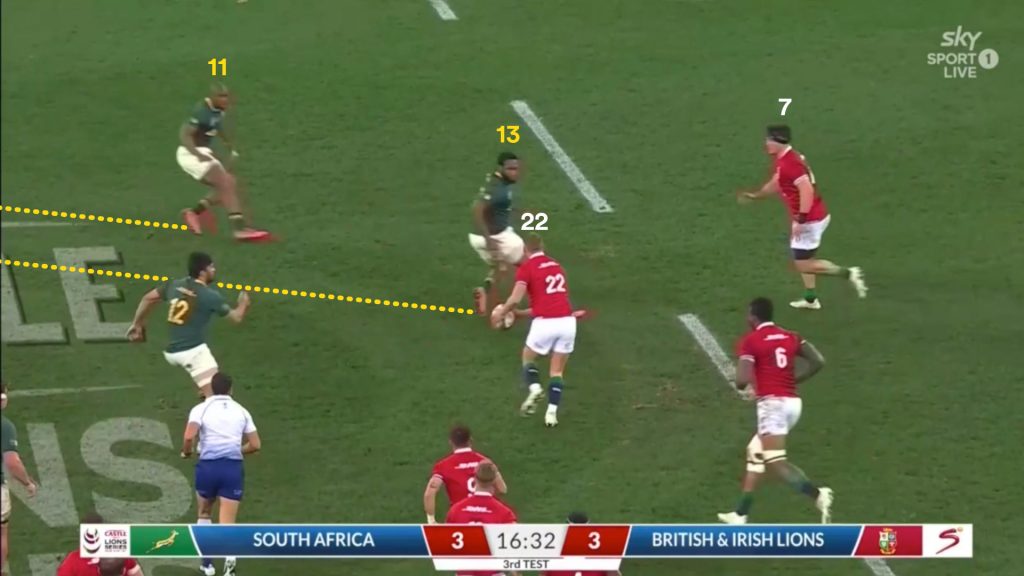

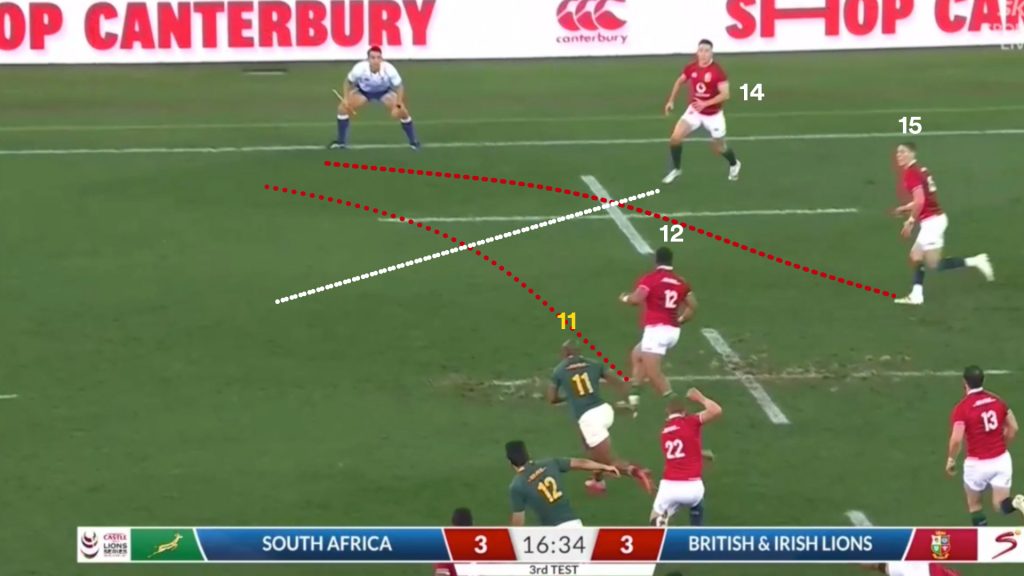
The Lions have support players wrapping around Adams (14) in Bundee Aki (12) and Liam Williams (15) and room to run on the right edge.
One aspect of the Lions attack that really let them down on the night was not using every inch of the field available. This is a philosophy driven by the likes of former All Black assistant Wayne Smith that has been part of the All Blacks counter-attacking framework for years: use the full width of the field to spread the defence.
At 70-metres wide, if you only use 50 or 60 of it, you are making the job of the defence that much easier. When faced with a defence like the Springboks where space is at a premium, you simply have to use it when you get a half-break and unmarked men on the outside.
While a massive talking point was Williams’ missed two-on-one, this was equally a missed opportunity from the Welsh wing, although not as pronounced.
Adams (14) cut back inside Mapimpi (11) and the Springbok winger is turned inside-out. His two Lions teammates have pushed hard to get on the outside and provide support options. Adams (14) with the ball tucked, isn’t thinking about keeping the play alive.
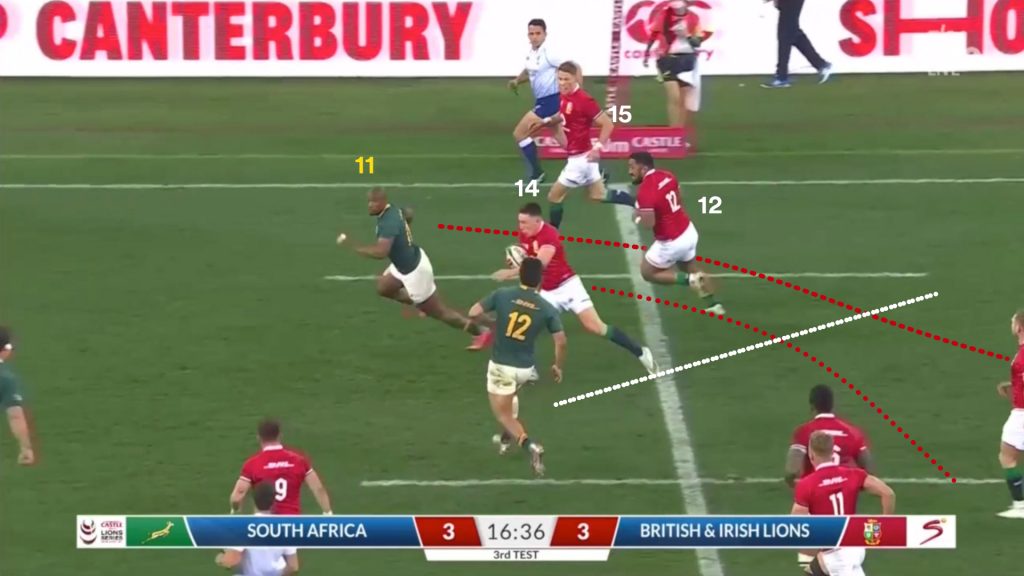
Pollard (10) is the last man in the backfield on this side of the field, and when he comes into picture he is fixed in a stationary position bracing for impact with Adams. The ball simply must go back out to Aki in this situation with about 10-metres of width to use to the touchline.
Mapimpi (11) is turned in looking to come back at Adams, but the Welsh winger stepped off the right foot again to go at Pollard’s inside shoulder and is tackled in a two-man sandwich with Number 8 Jasper Wiese.
It would have taken a sublime piece of skill by Adams, but the right move would have been to attack Mapimpi, get him to commit to a tackle, and get the ball to the outside where the two free men are with a chance to draw the last line of the defence.
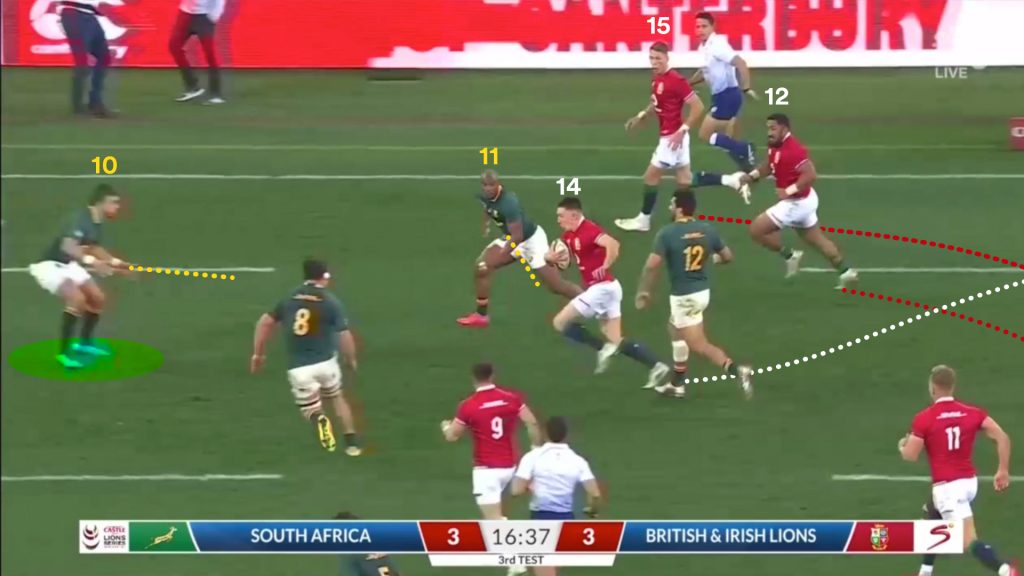
That might not be Adams skillset but unfortunately that is what is required in this situation against this defence. Adams is telling the defence he is going to run the entire time, with the ball tucked away it is an easy read without maximising the space or support available.
The Lions did keep pushing forward from this possession, earning a penalty and ultimately getting the try anyway through a driving maul from five metres out.
But that isn’t going to be the case every time in test rugby and it was proven the next time around. When the Liam Williams two-on-one was botched, the driving maul from the ensuing penalty went to waste when Tom Curry was penalised, handing over key possession and leaving the Lions without any points.
That passage of play leading up to that moment for Williams is important though, not for the Lions now but for all three teams in the Rugby Championship as there were warning lights for the Springboks.
Following a kick receipt the Lions fall into their shape and look to attack width immediately from the 15-metre tramline on the right side heading left.
This is less than 30-minutes into the game and it is apparent just how loose the Springbok edge defence is. The Lions play out the back to Finn Russell (10) from a standard three-man pod to start the chain of movement.
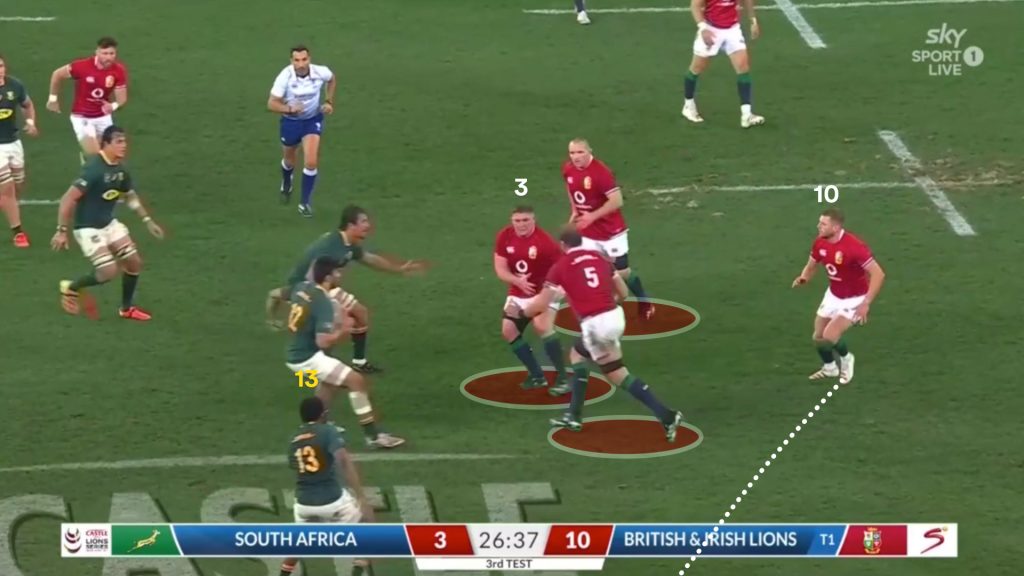
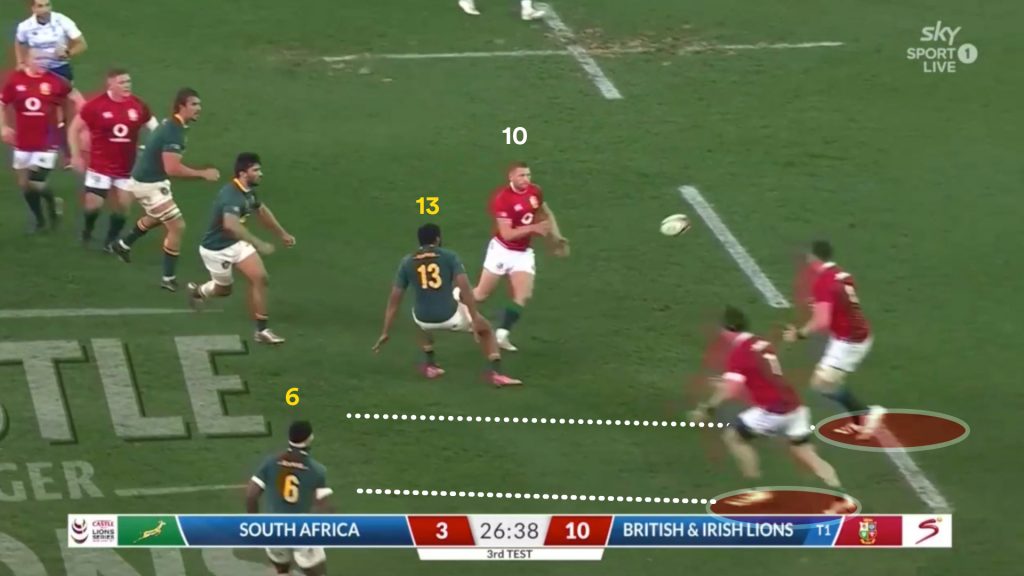
Russell has not one, but two, wide open loose forward runners outside him, Tom Curry and Jack Conan, as Am (13) and Siya Kolisi (6) leave a massive lane open. Am is nowhere near shutting down the play here, which is telling as this is what the Springbok system survives on.
Russell’s pass goes out the back to Henshaw (13) who again has acres of time and space with Cheslin Kolbe (14) also not applying enough pressure to funnel play back inside.

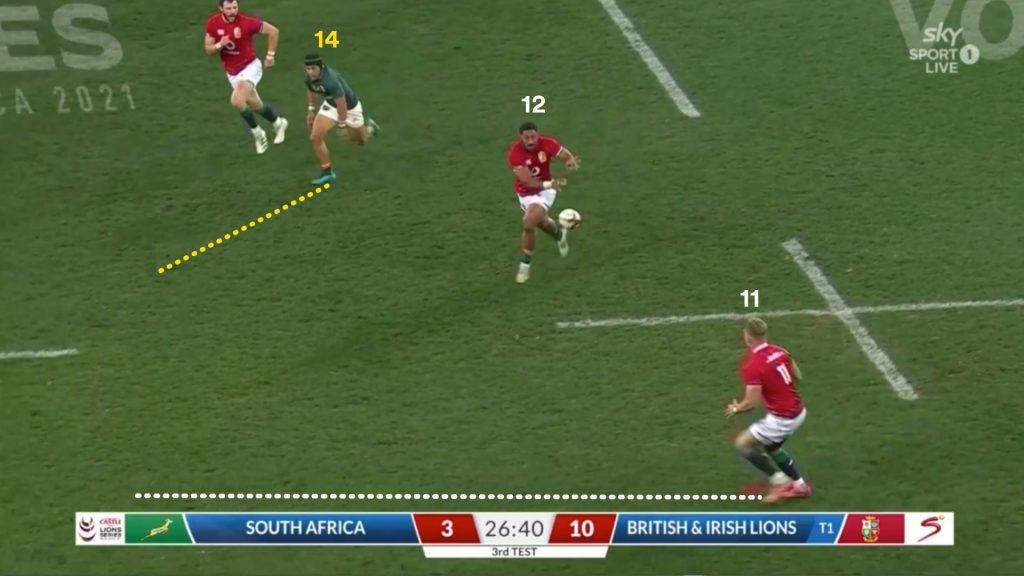
The ball reaches Aki (12) easily. This is where the Lions again fail to use the space effectively, with the midfielders switched around with Aki outside Henshaw instead of Henshaw outside of Aki.
When the ball moved outside of last front line man, Kolbe (14), the Lions needed a genuine outside centre or fullback to crystallise the two-on-one and set Duhan Van der Merwe (11) free.
In the same way Le Roux straightened his line and drew the defender to put Kolbe away in the second half, Aki needed to straighten and try and take Le Roux out of the picture and preserve space for his wing.
Aki doesn’t do that, he offers early ball allowing the Springbok defence to push out. While Van der Merwe can take the space ahead of him, he now has to take on Willie le Roux one-on-one and there is no one in the space outside him.
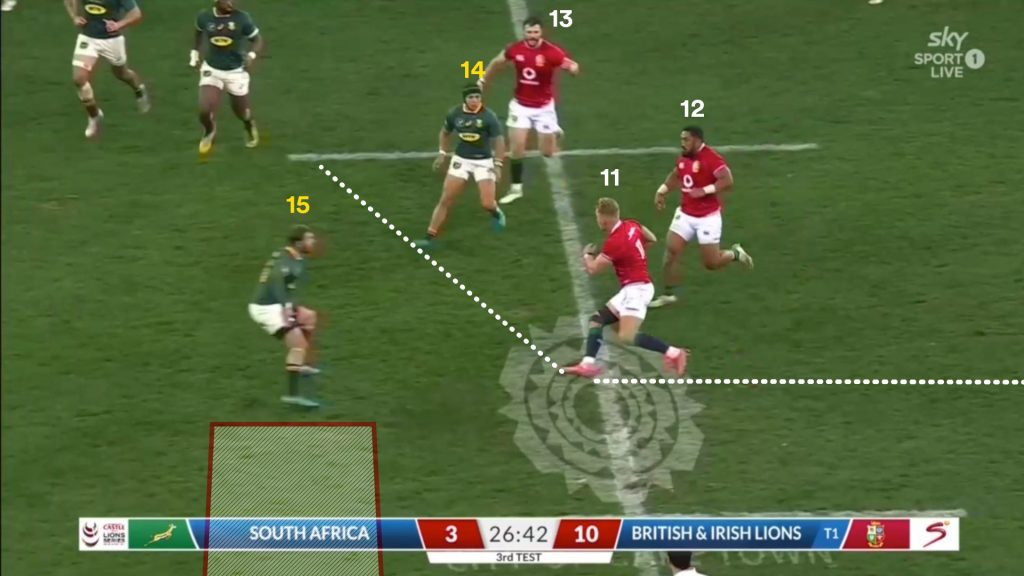
Once again the Lions don’t use the full width of the field and fail to fully capitalise on breaching the Springboks out wide. Aki (12) becomes a meaningless support player and the numbers aren’t effectively used.
Duhan Van der Merwe cuts back up field and chews off plenty of metres, but the coaches would have probably liked to see him running down the left touchline with a chance to score in the corner or beat the remaining cover defence.
This is then where the Liam Williams play came as the Lions worked back to the opposite side.
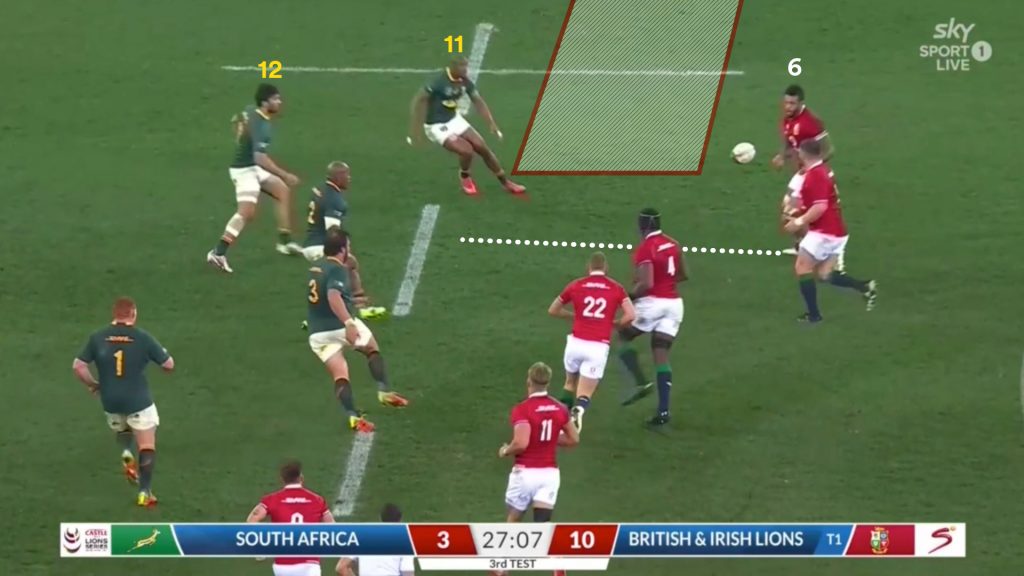
The Lions have all the momentum and Russell begins to play right on top of the defence, creeping closer and closer to passive line as the Lions take metres. He plays a long ball to Courtnay Lawes to puncture the defence between the last two defenders.
On the next phase Russell is ready to pull the trigger. Mapimpi (11) is caught with two props to his inside and nearly 20-metres of unmarked space outside.
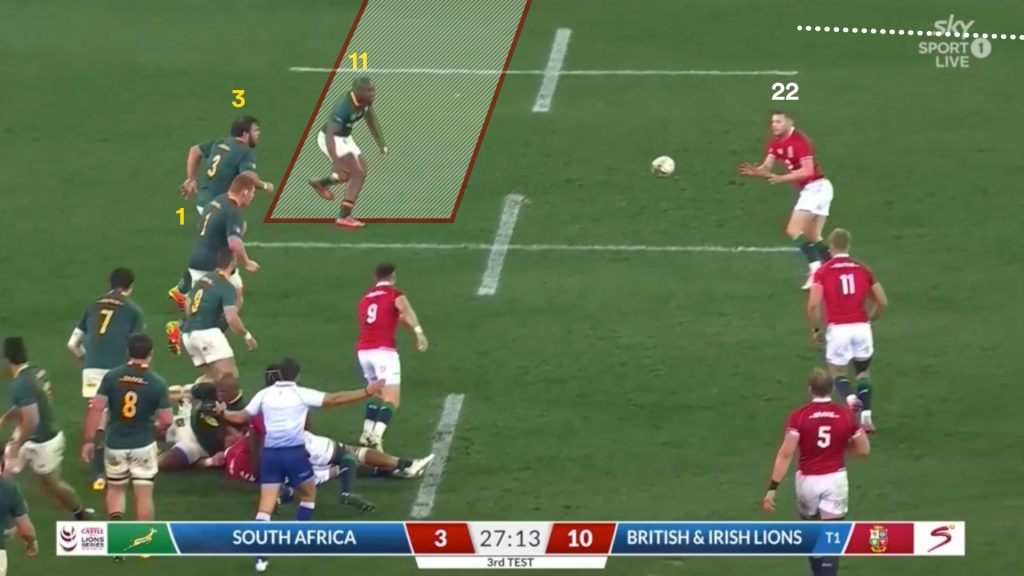
We see the Lions once again move the ball outside the winger via a Finn Russell cutout pass with space to run. Henshaw does a great job holding Mapimpi by running a tight line next to the Scotland flyhalf.
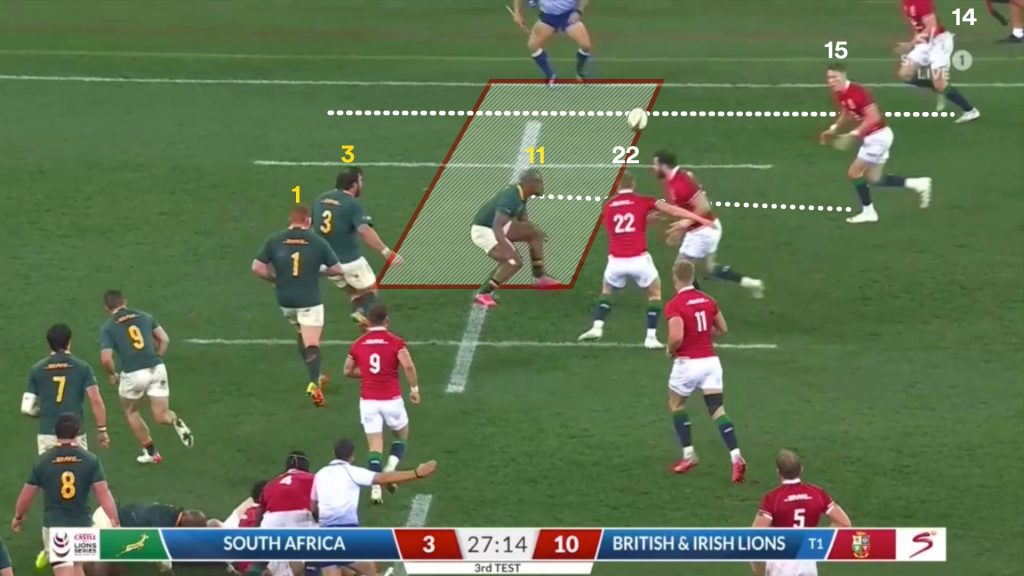
The Welsh fullback did what Aki needed to moments earlier, keeping straight and taking the ball to the fullback.
Obviously what happens next is inexplicable as Williams is a fullback by trade and 99 times out of 100 would make the right play. Not only is Adams unmarked outside, Robbie Henshaw is on the inside with prop Malherbe the nearest defender.
Inside and out, the Lions have the numbers to finish this break and go up by 17-3.
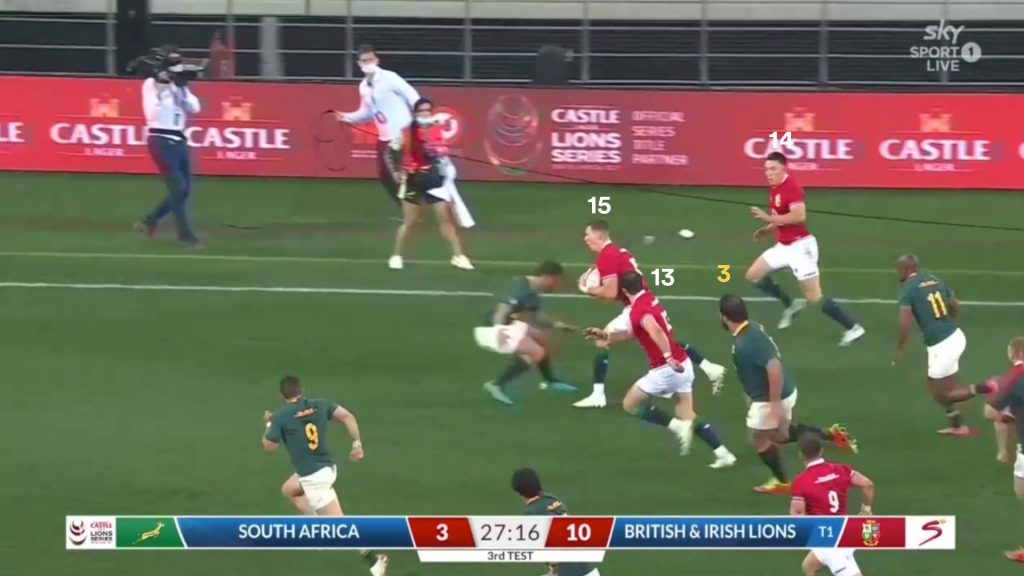
That Williams let them off the hook doesn’t remove the fact that the Springboks defence was exposed, twice in a row on the edges.
The Lions looking at this tape will be ruing the missed opportunities. The All Blacks, Wallabies and Pumas looking at this tape, will be excited at what they see. This is less than half an hour into the test and the intensity is not there at all from the Springboks in a decider for the Lions series.
After the Lions found success on the fringes, it was puzzling that they did not try to test them more frequently. The pressure was not getting there in time from the likes of Am, Kolbe and Mapimpi, and with a skilled operator like Russell having the game of his life, not getting him more ball was criminal.
At 10-3 the Lions get another attacking set-piece opportunity a few minutes after the Williams’ non-pass and failed maul attempt.
They run Ali Price off the base and use a stack in the midfield to condense their backline. Russell (10) and Van der Merwe (11) are there to float out the back and overload the far side.

Price gets so far out from the scrum that the Lions have the numbers to strike wide by going out the back to Russell.
The rush is not coming hard enough to stop Russell making something of this opportunity, with both wings and a fullback outside him.
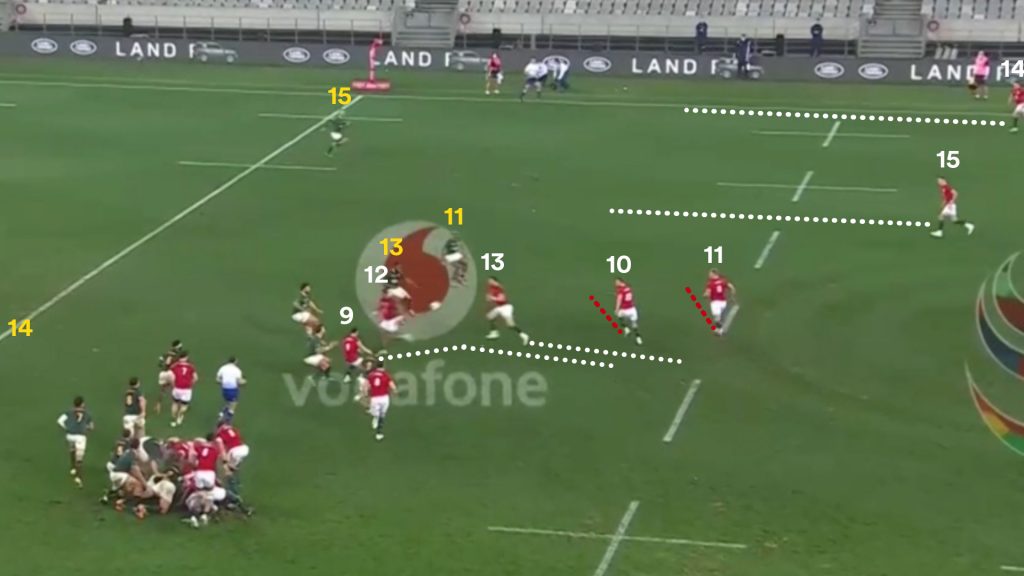
Ali Price opts to hit Henshaw for a crash ball instead, when just minutes earlier Russell had exposed Mapimpi on that edge. Now he had a chance to do it from set-piece, a much harder situation for the Springbok to defend.
We’ve seen the passes Russell can make in this situation for Scotland so it’s hard to understand what the thinking was, and whether the right conversations were being had prior to the scrum after the Lions previous breaks down the edge.
Once the ball goes out the back of Henshaw, outside centre Am (13) would definitely slide but Mapimpi (11) has a habit of jamming in, that is what his system calls for most of time.
Allowing Russell to test that edge again and find out what Mapimpi’s decision would have been was the right move to make.
If Mapimpi slides, Russell takes contact from Am and plays Van der Merwe off his hip into a sliding doors gap. If Mapimpi jams in, he throws the cutout ball to Williams.
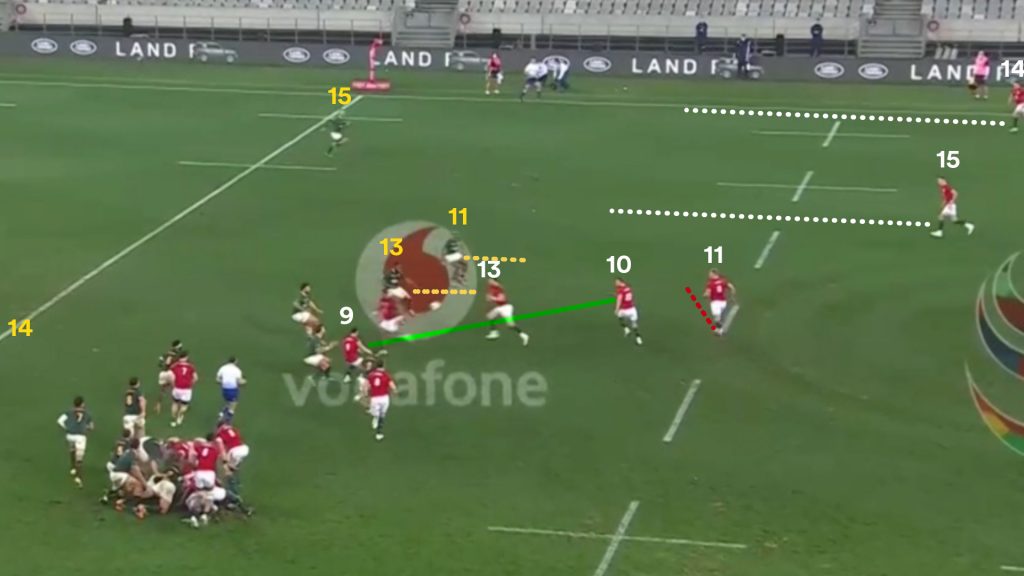
You have to give your playmaker a chance to make the play, and Price failed to do that.
He may have done it again right on the stroke of halftime when the Lions’ backs had a chance to attack right after a slow build up.
We don’t get a wide shot after this one during the build-up, but we can gather that Pollard (10) and Mampimpi (11) are the last two defenders on the left edge and that the Lions have Aki (12) and Adams (14) out that way.
Lukhanyo Am (13) later folds over to line-up inside Pollard (10) when the Lions forwards creep further towards the posts with pick and goes.
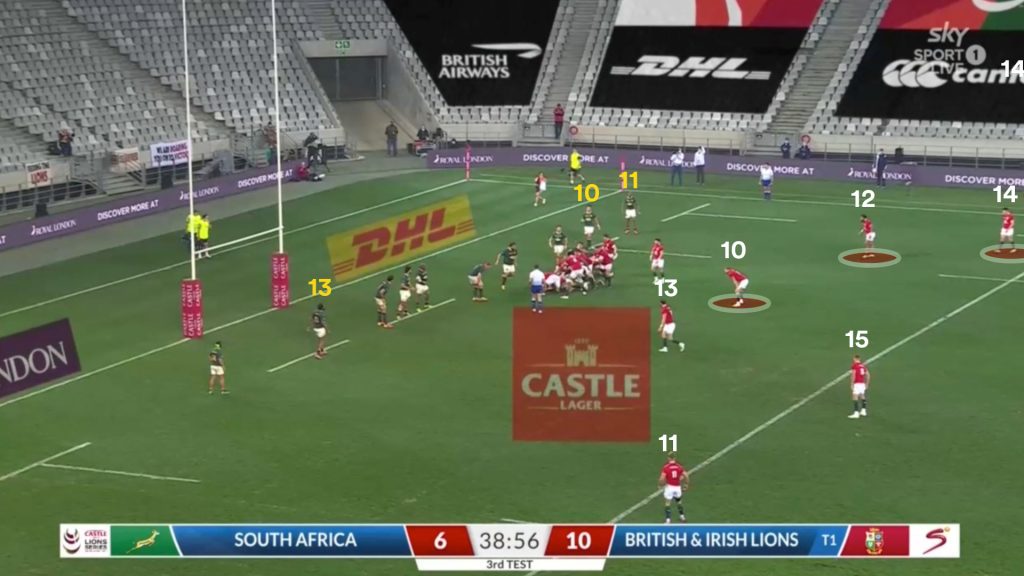
When the Lions’ backs call for the ball from Price, they have at minimum, three players out to the right, Russell, Aki and Adams. Liam Williams may have also shifted over that way.
We know the last defender is Mapimpi outside Pollard, so its a three-on-three situation across half the width of the field. If Williams moved over there, it’s four-on-three in the Lions favour.
That is incredibly difficult to defend, yet Price doesn’t feed Russell the ball.
After running three paces off the ruck, he withholds the pass and circles around back towards the forwads. Itoje strips Price of the ball, carries and is isolated conceding a holding on penalty, blowing the possession.
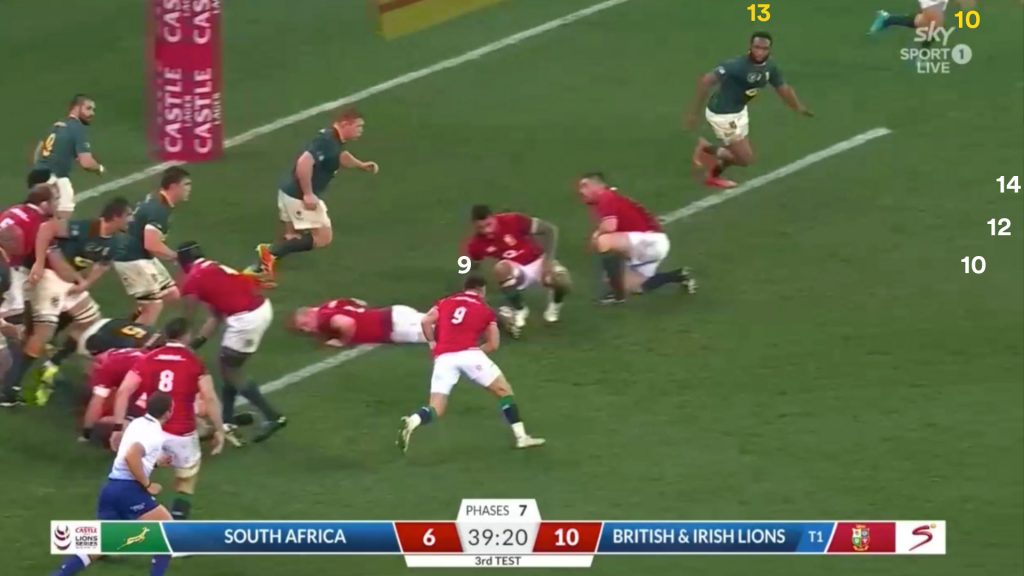
The pressure was coming from the Springboks but it would have been far less had Price just passed off the deck to start with. Even so, Russell could still make a play as the line speed hadn’t bothered him all night.
For Price, this ball just has to go, no excuses. It was a poor decision on an off-night for the Scotland halfback and why he pulled it back remains unknown.
Russell can decide if the rush is too hot, he can use footwork to limit the effectiveness of Am’s tackle and buy time for support but the opportunity is just too good to give up like that.
The difference between Price here and Aaron Smith against the Wallabies is stark. On top of the Wallabies goal line, Smith knew when to pull the trigger and got the ball to the space no fuss straight off the deck for two tries to McKenzie and David Havili.
Price looked to run first, bailed on the opportunity his backs had, and indirectly caused a turnover at the most critical junction of the match.
When they look back on the second and third tests, the Lions will rue not finding a better balance between the aerial game and playing ball-in-hand rugby to pressure the Springboks in the wider channels.
Although the Springboks continued to struggle under the high ball, all the signs were there that opportunities were to be had out wide. Many of the Lions’ attack patterns, particularly inside the Springboks’ 22, were too slow and power-based. They did not look to strike wide directly off any platform.
The concerning aspect for the Springboks is in the high-stakes deciding test with everything on the line, their high-pressure defence was non-existent less than half an hour into the match.
That is a major red flag heading into the Rugby Championship and their Southern Hemisphere rivals will be licking their lips at the prospect of testing it out. No doubt the lack of preparation before the Lions series is taking a toll just as they enter a long stretch of tests.
If this pressure defence system cannot generate pressure, the All Blacks will put 30 points plus on them. Jordie Barrett or Damian McKenzie will find Will Jordan or Sevu Reece in a situation that Liam Williams was in and the Springboks will be standing under their posts most of the night.
But it will be the Pumas who get the first crack, flying under the radar all while the Springboks try to prepare following their celebrations after the Lions series win.
You couldn’t get a better time to have a crack at the World Champions.


Comments
Join free and tell us what you really think!
Sign up for free